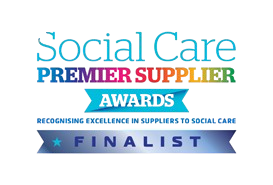Introduction
“How do you market a home care agency?” is one of the most pressing questions for providers today. Unlike other industries, home care is deeply personal. Families and older adults are not only buying hours of support; they are placing immense trust in carers who will come into their homes, often at vulnerable times. Successful marketing can't be chalked up to slogans, gimmicks, or luck; it's about grasping the importance of visibility, reassurance, and credibility.
Self-funding clients, who fund their own care independently, are a growing and vital audience. Approximately half of older people in England pay for the social care they receive, either because they're not eligible for public social care or because they choose more flexible, higher-quality services (Baxter et al., 2019).
Understandably, self-funding clients are far more discerning. They expect professionalism, transparency, and high standards. As such, in order to appeal to them, a sound marketing strategy is essential; one that incorporates the wants and needs of clients while addressing the concerns of people around them, from their family members to professionals involved in the care sector.
To address this challenge, we apply the AAC framework:
Audience – the foundation: understand exactly who you are speaking to.
Awareness – ensure your target audiences can find you at the right time.
Credibility – once they have found you, prove you are the provider of choice.
Below, we outline nine trade secrets, mapped to Awareness and Credibility, and supported by research and practical strategies. Together they offer a structured answer to the question: how to market home care successfully to attract private clients.
Audience: Your Foundation
Know Your Audience:
Let's be clear: the market for home care is far from just one group.
Rather, the market is composed of many groups, all with different wants and needs.
Families: Often adult children, they want reassurance that their loved ones will be well-looked after in their twilight years.
Residents: Older folk want a good mix of comfort and community; they may need help with daily tasks and live-in care too.
Referrers: GPs, hospital discharge teams, and social workers as safeguards; they point families towards high-quality home care.
Local authorities: They don't fund care but they provide vital guidance to families looking for quality care, so keep them in mind.

The home care market can be a nightmare for self-funders navigate, so people often look to experts and friends for tip and recommendations.
It's very common for people to check online for good reviews before they call you. In fact, research shows that 94% of people looking for a home care think online reviews are trustworthy and helpful sources of information.
The main group you'll need to watch out for are families, as they typically search for home care on behalf of their loved ones.
Recommendation: tweak your services to appeal to every group. For example:
Families: run “family evenings” where relatives can meet the managers and ask important questions.
Residents: offer “trial days” where potential residents can sample the meals, take part in an activity, and chat to current residents.
Healthcare professionals: send regular updates to local GPs and hospital teams with key info on your training, services, and standards.
Local authorities: invite commissioners to open days and provide them with simple compliance summaries.
Despite their different priorities, all these groups are very important to choosing a home care agency, so market yours wisely.
Awareness: Make Yourself Known
Build a Strong Digital Foundation
Your website is your first impression.
As such, like all first impressions in business, your website should be professional.
In order for your audience to get the most out of your services, your website will need:
Make sure your website is up to date, well-designed, and user-friendly; make sure it's mobile-friendly too.
Provide clear information about your services, fees, and CQC ratings (or whatever equivalent you're using.)
Include high-quality pictures and videos of your carers and clients.
Provide different, easy-to-find contact options: phone, email, and online forms.
Use SEO strategies using phrases like “private home care near me“ or similar.
It’s common for clients to inquire further, so make enquiries easy with visible phone numbers and simple online forms. Have these contact details at the top or bottom of your website, not buried away in drop-down menus or internal pages.
Recommendation: use PPC advertising to latch onto the most popular searches with families looking for home care.
It's really important to get this right.
Families will almost always start digitally when looking for home care; it's a competitive and rapidly digitising sector.
Not only that, around nine in ten (89%) people aged 65 to 74 in the UK, use the internet at least once a month for personal use - that's roughly 6 million people.
If you want your home care agency to be taken seriously, you must take its website seriously.
The team at Bridgehead is brilliant. They have a unique understanding of the media and home care marketing.
Get Found Through Local Search
People don’t just want any sort of home care.
Residents want home care that will keep them near their loved ones and vice versa. This is why searches like “home care near me” or “private carers in Reading” are extremely common among families looking for home care.
As such, there’s an entire chunk of the market that is specifically looking for your home care agency, they just need to help finding it.
There are many methods you can use to stand out in a competitive market, such as:
Maintain an accurate Google Business Profile with up-to-date services, contact details, and high-quality media; remember, your digital impression is your first impression.
Encourage families and residents to leave positive, detailed reviews; 84% of people trust online reviews as much as personal recommendations.
Use localised keywords to optimise local SEO, such as: Regions (e.g. South East), Counties (e.g. Kent), Cities (e.g. London), Towns (e.g. Derby), Villages (e.g. Ripley), Districts (e.g. Barnet), and Streets (e.g. Bond Street).
Make sure your Business Profile is regularly updated with fresh info about new services, community events, achievements and awards, and other things you want your audience to know about.
Recommendation: Combine positive reviews with Google Ads or YouTube advertising; this is a great way to ensure your home care agency is discovered by families.
Clients want to know you're local so they pick-up the phone and make the call, so be sure to let them know.
Make Social Media Work for You
In a rapidly digitising sector, you’ll need to make social media work for you.
For home care, social media it's about showing the human side of care; it's a tried-and-tested way you can build emotional engagement between your home care agency and your clients.

There are many ways you can use social media to humanise your home care agency, such as:
Share positive and authentic stories about your carers
Highlight staff training, community engagement, and milestones
Share positive reviews; never forget how important they are.
Post a “Photo of the Week” to give a glimpse into the world of home care
Share video snippets from behind-the-scenes of staff training
Promote your carers with "Meet the Carers" posts
Social media should not be about follower counts but about reassurance, visibility, and credibility
Recommendation: paid social media advertising and boosted posts can amplify this content to reach families who are researching care options in your local area; don't just promote your agency, promote your promotions.
Social media can be a window into day-to-day life, so use yours to cultivate the warmth, personality, and value-driven care you want to be known for.
It’s not just about building followers, it's about building faith and trust with your audience.
Connect With Your Community
Building connections with your community is key to building connections with your audience.
In fact, your community isn’t just a part of your audience; your community is your audience.
Families often rely on local word-of-mouth and community reputation as indicators of quality. Engagement and community connection reduces loneliness and improves health outcomes for older adults.
There are a multitude of ways to build visibility and goodwill, such as:
Partner with local charities for fundraising and campaigning.
Sponsor community events, awareness initiatives, or intergenerational projects.
Place leaflets in community centres such as libraries and pharmacies..
Invite community groups to seasonal celebrations.
Hosting open days and workshops so potential clients can meet your staff.
Other local events, like community fairs and coffee mornings are also great ways to increase your recognition and attract families who may not have been actively looking.
These activities not only attract potential residents but also strengthen relationships with local organisations and influencers.
Recommendation: As established, people search for local home care, so good community relations aren’t just good but essential. If you incorporate community involvement into your social media game; you'll build trust with the kind of people you want to attract.
If you want to get to know your audience, there are few better ways than getting to know your community.
Credibility: The Secret Ingredient
Shine a Light on Your Carers
Carers and nurses are your strongest ambassadors.
The work they do is not just the backbone of home care, but home care marketing as well.
Families judge quality by the people delivering care and their impressions are shaped by staff professionalism and visible dedication.
Highlighting their efforts creates a personal, warm, relatable image of your home. There are various things you can emphasis to show your credibility, such as:
Training: share photos or short posts when staff complete new qualifications or courses; interviews or quotes demonstrate professional growth.
Achievements: run “Staff of the Month” spotlights, awards, or feature stories about going the extra mile; make sure to celebrate all your wins, big or small.
Personal commitment: post “Day in the Life” pieces or videos of staff leading activities, explaining why they do what they do; the human side of care.
Recommendation: include profiles carers on your website and social media; show their training, motivations, and personal stories.
Recognition not only reassures families about the quality of care but supports recruitment efforts.
This recognition your staff receives also boosts morale, helps recruitment, and reassures families that your team delivers quality care.
If you want to show that you care about your audience, show that your staff care about their loved ones.
Show Real Stories of Care
Data can be useful, but it’s not the be all and end all.
It’s important that the stories you tell are real human centred stories. Testimonials and case studies are vital in persuading families. Authentic storytelling enhances credibility and influences decision-making in senior care.
This can include things like:
Testimonials from families: collect genuine feedback, turn these into short videos or quote graphics for your website and social media.
Publish case studies: directly how how your service supported care and recovery of your clients.
Profiles of carers: feature “Meet the Team” articles or videos showing staff backgrounds, specialist training, personal motivations.
Resident milestones: celebrate birthdays, anniversaries, or achievements with photos and a short write-up.
These are the stories which resonate with the public, whether they’re searching for home care or not.
Families want to picture their loved ones thriving, not just being cared for, so it’s very important for you to include happy and healthy residents in any material you use.
Recommendation: use high-quality photography, videos, and stories of daily activities, you can bring the home care you provide to life.
Pictures and videos of residents and families talking about their experience are far more powerful than written blurbs alone. Visuals in particular strongly influence perceptions of care.
These visuals reinforce your credibility immensely; it shows you’re the real deal and that you’re confident about the care you provide.
Don’t just tell people that your home care agency is right for them... show them.
Work With the Media to Amplify Good News
Not all marketing will come from you alone. In fact, some of the most effective and impactful marketing comes collaborating with the media.
Local media coverage is paramount is paramount; families trust external validation more than self-promotion, so media coverage shows authority and legitimacy.
It shows that you mean business.
Share stories with the local press; from carers going above and beyond to awards and milestones.
Maintain relationships with local journalists; you want your agency to become a recognised, official source.
Capitalise on media appearances by drawing attention to them with social media.
Establish yourself as the “go-to” for care insights, both in the community and the wider care sector.
When families see your care reported in trusted media, you'll gain an edge on your competitors.

Recommendation: write articles, participate in interviews, and publish press releases, and participate in sector-relevant events to build your reputation as an authority in the world of home care.
While not guaranteed to increase bookings, good media coverage not only increases your standing among those looking for home care, but among those not may not be actively searching yet.
By maintaining good relationships with local journalists and leveraging your press connections, you can present yourself as a thought leader in the sector.
A lot of news can be pessimistic, aggravating, and nerve-wracking, so you’re well positioned to provide some much sought-after good news.
Track What’s Working — and Adapt
Good marketing is not set-and-forget.
Your reputation is precious, so why leave things up to chance?
The market is too competitive to make decisions on vibes alone. Research shows that agencies with a data-driven strategy towards communication outperform those relying on word-of-mouth alone.
Therefore, if you want to do this properly, you’ll need to understand a few things:
Use analytics to track website traffic, enquiry sources, and conversion rates.
Ask every new client where they heard about you; this will help you focus your efforts.
Monitor your campaigns (leaflets, PPC, social media) and see which produce the best returns.
Use evidence to refine your strategy; constant improvement is key.
Data-driven marketing demonstrates professionalism and ensures continuous improvement.
Credibility is strengthened when you can show stakeholders — families, staff, investors — that you measure and improve continuously.
Recommendation: watch your SEO, make use of Google Ads and similar tools, grasp social media campaigns, and embrace digital advertising.
Be sure to stay on top of a variety of metrics that will help you navigate the market and stay competitive. Use this feedback to refine your campaigns or double down on channels delivering results.
Regularly review your metrics to ensure you’re not just active but effective; it signals to stakeholders that your care about your home care.
Data isn’t the be all and end all, but it’s still very important; it’s the definitive proof that you’re a credible supplier.
So, how do you market a home care agency? The answer lies in combining Awareness and Credibility, built on the foundation of knowing your Audience.
Audience – understand clients, families, and referrers, and tailor communications.
Awareness – ensure visibility through digital presence, local SEO, social media, and community engagement.
Credibility – build trust with carers’ stories, authentic testimonials, regulatory transparency, and media validation.
Follow these nine trade secrets and you'll not only attract more private clients, but strengthen your reputation, build community trust, and demonstrate the quality of care that families, residents, and professionals are all looking for.



